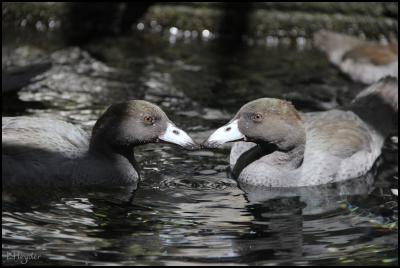Whio release on Styx and Arahura Rivers

Flockmate – this pair of whio matched. Photo credit L.Heyder - Isaac Conservation and Wildlife Trust.
Media release
13 July 2017
Whio release on Styx and Arahura Rivers
Tomorrow seven whio (blue duck) will be
released onto the upper Styx and upper Arahura Rivers near
Hokitika after nearly a year of whio wooing.
These blue ducks are the unsuccessful ‘flock mate’ applicants who were in a program to establish breeding pairs of South Island whio for what could be described as the ‘whio bachelor’.
The whio captive breed for release programme is currently setting up the South Island programme. A number of North Island breeding pairs around the country have been breeding for release for 17 years.
But creating breeding pairs involves a sort of dating process inside a large aviary through the flock mating process.
West Coast whio ranger Antje Wahlberg says the whio pairs have actually been bred from eggs collected from the Central Southern Alps whio security site located in the backcountry behind Hokitika.
The eggs are hatched and reared by the Isaac Conservation and Wildlife Trust (ICWT) at Peacock Springs in Christchurch, and the juveniles are usually returned to the wild the following autumn. The Isaac Conservation and Wildlife Trust operates the largest whio breeding facility in New Zealand and has been breeding whio for release for close to two decades.
“This ensures wild eggs survive incubation and the duckling stage, because in the wild many are lost to predation by stoats. However, collecting wild eggs can be a time consuming and costly method, so establishing South Island captive breeding pairs will help the programme,” she says.
About a dozen whio from last season’s egg lift programme were not released as juveniles at the start of the year. They were held back to go through the flock mate (courting) process to establish the breeding pairs.
“It’s quite a process and involves filming the whio in captivity with infra-red cameras, as the young whio hang out together and the females choose their mate, with most of the action happening at night.
The staff at the Isaac Conservation and Wildlife Trust viewed hours of video footage to see which whio bachelorette picked which whio bachelors!
The seven birds to be released tomorrow, did not ‘receive a rose’ in the flock-mating game and did not pair up, but hopefully will find their partner in the wild.
All offspring from the new breeding pairs will be released back into the wild to boost the population of the security site to reach the target of 50 pairs.
Genesis Energy and the Department of Conservation have partnered together to secure the future of this unique vulnerable native bird. Operating under the name of Whio Forever this partnership is fast tracking implementation of the national Whio Recovery Plan to protect whio and increase public awareness.
Ends
Background Information on whio
The whio is a threatened species of native
duck that is only found in New Zealand’s fast flowing
waters. Featured on New Zealand’s $10 note and with an
estimated nationwide population of less than 2500 birds,
whio are rarer than kiwi.
Whio are adapted to live on
fast-flowing rivers so finding whio means you will also find
clean, fast-flowing water with a good supply of underwater
insects.
This makes whio important indicators of
ecosystem health – they only exist where there is high
quality clean and healthy waterways.
WHIO
FOREVER
Genesis Energy has a strong historic
association with whio through the Tongariro Power Scheme and
in 2010 this association grew through the establishment of
Whio Awareness Month (March).
Today, Genesis Energy and
the Department of Conservation (DOC) continue their
partnership through the Whio Forever Programme, which aims
to secure the future of whio in the wild and ensure New
Zealanders understand and value of whio in our
rivers.
The support of Genesis Energy and the work of DOC
has enabled the Whio Recovery Plan to be
implemented.
CONSERVATION ISSUE
The whio are
eaten by stoats, ferrets and cats, with the largest impact
during nesting time when eggs, young and females are
vulnerable, and also when females are in moult and can’t
fly.
Extensive trapping can manage these predators and
work in key whio habitats by DOC and Genesis Energy on the
Whio Forever Project has already seen an increase in whio
numbers.
Whio cannot be moved to predator-free islands
like other species because of their reliance on large
fast-flowing rivers.
Pairs occupy approximately 1km of
water – so they need a lot of river to sustain a large
population and they fiercely defend their territories, which
makes it difficult to put them with other ducks in
captivity.
They are susceptible to flood events which,
destroy nests, fragment broods and wash away their valued
food
source.


 Entertainment Venues Association of NZ: New Ticketing Code To Enhance Confidence Of Ticket Buyers And Event Providers In New Zealand
Entertainment Venues Association of NZ: New Ticketing Code To Enhance Confidence Of Ticket Buyers And Event Providers In New Zealand RNZ Online: Aotearoa Has Multiple Clouds So Unique They Have Names
RNZ Online: Aotearoa Has Multiple Clouds So Unique They Have Names Organics Aotearoa NZ: Genetic Engineering Reforms Risk Making NZ An Outlier
Organics Aotearoa NZ: Genetic Engineering Reforms Risk Making NZ An Outlier Bill Bennett: Spark lowers FY2025 forecast, plans Connexa stake sale
Bill Bennett: Spark lowers FY2025 forecast, plans Connexa stake sale NZ Trucking Association: Free Transport And Logistics Recovery At Work Programme
NZ Trucking Association: Free Transport And Logistics Recovery At Work Programme Scion: Virtual Reality Adds Another Tool To Forestry Training Kit
Scion: Virtual Reality Adds Another Tool To Forestry Training Kit



